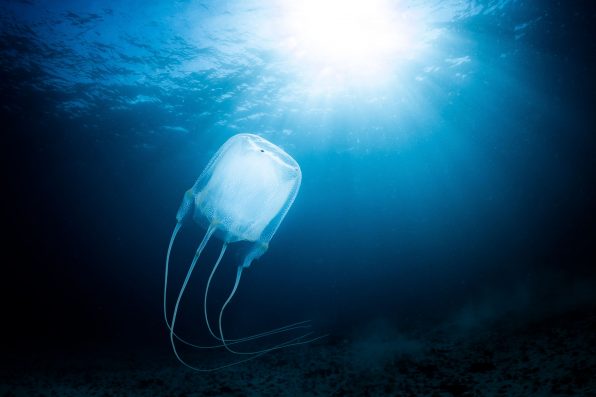The Box Jellyfish May Not Have A Brain, But A Study Has Shown This Tiny, Translucent Creature Still Has The Ability To Learn From Past Experiences

The box jellyfish swims in the warm waters of the Caribbean, searching for small crustaceans to eat while carefully avoiding the roots of mangroves, which could easily cause damage to their soft bodies.
The tiny, translucent creatures are about the size of a grape, and they do not have brains, yet they are capable of learning from past experiences.
Researchers have found that although Caribbean box jellyfish lack a central brain, the animals have figured out how to spot and maneuver around obstacles.
It is the first example of jellyfish engaging in associative learning, which is the ability to make mental connections between events and then alter behavior accordingly.
A 2023 study published in Current Biology suggests that the jellyfish use this learning ability, along with a complex visual system, to navigate through mangrove swamps.
In a series of experiments, scientists set up a habitat inside a small tank that mimicked the box jellies’ natural environment. They lined the inside of the tank with alternating vertical stripes.
One scenario featured black and white stripes meant to imitate mangrove roots in clear water. Another had gray and white stripes, which represented mangrove roots in murky water.
Then, the scientists dropped 12 jellyfish in and recorded the creatures’ behavior over seven and a half minutes. The jellyfish in the tank with clear water conditions easily avoided running into the wall.
On the other hand, the jellyfish in the murky water conditions collided with the tank wall at first. However, it did not take long for them to change their behavior.

Enrico – stock.adobe.com – illustrative purposes only, not the actual jellyfish
After just a few run-ins with the wall, their average rate of collisions quickly dropped from 1.8 to 0.78 per minute while their average distance from the wall increased from around one inch to 1.4 inches, according to Maria Temmings from Science News.
The final scenario involved placing jellyfish in a tank with no stripes at all, just a solid gray wall. The scientists discovered that the jellyfish kept bumping into the wall and never adjusted their behavior.
This was because they had no visual cues. It appeared that the jellyfish could only learn something when they had a combination of visual and mechanical stimulation.
So, of course, the researchers looked into the role of vision in jellyfish navigation. Caribbean box jellies are one of the few species that have eyes. They have four vision centers called rhopalia, each containing six eyes and over 1,000 visual neurons.
The researchers isolated the rhopalia from the jellyfish, giving the rhopalia a small electrical shock to simulate the jellyfish bumping into a mangrove root while showing them striped images.
In about five minutes, the rhopalia caught on and began sending out the types of signals that would cause a jellyfish to swim away from something. The results of the experiments suggest that rhopalia serves as a learning center, and jellyfish are capable of associative learning.
Since jellyfish are among the world’s oldest animals, appearing in the fossil record more than 500 million years ago, the findings can also help scientists understand more about the evolution of learning.
Sign up for Chip Chick’s newsletter and get stories like this delivered to your inbox.
More About:Animals